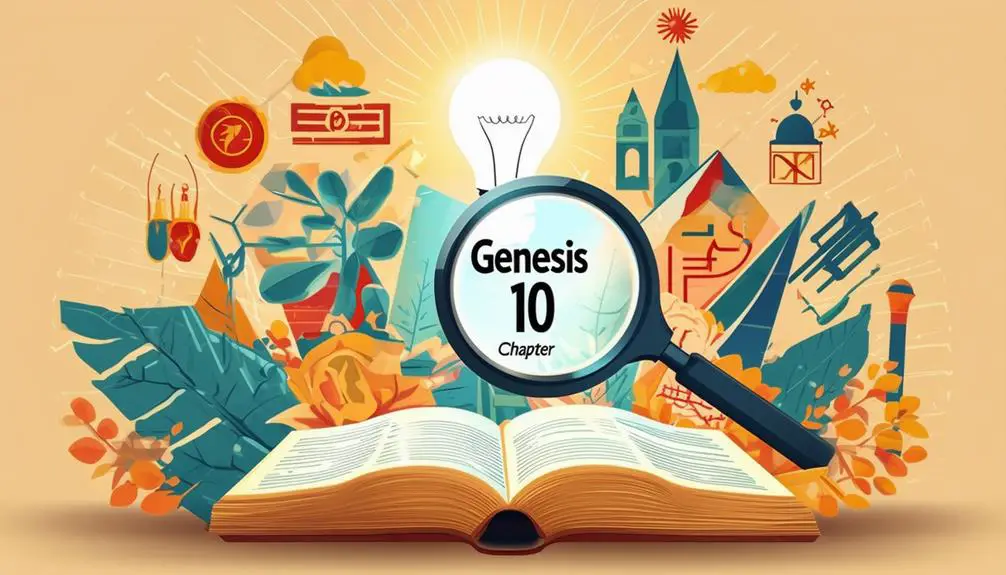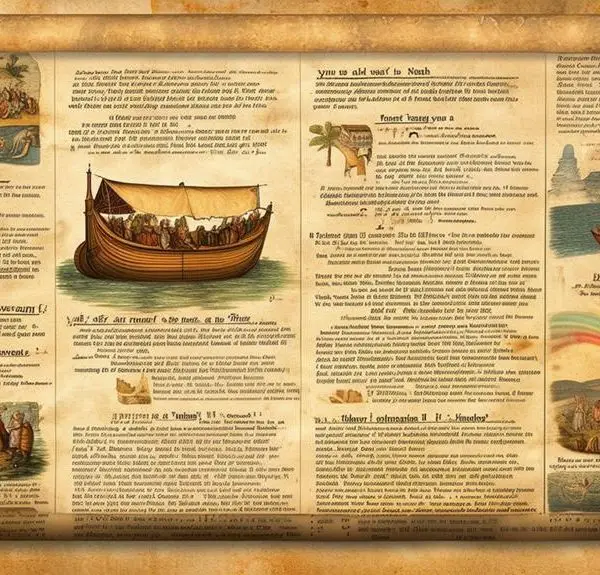Learn about Genesis 10's profound implications on identity, cultural diversity, and divine guidance in human history, in this comprehensive Bible study.

Bible Study – The Book of Genesis – Chapter 10 – Summary and Analysis
Genesis 10 provides a fascinating genealogical account post-Noah, often dubbed as the 'Table of Nations'. This chapter maps the world's ancient perceptions and cultural relations, showcasing how Noah's descendants dispersed and formed unique nations and languages. Key events include the founding of ancient cities to highlighting Nimrod's rebellion against God. Symbolism in Genesis 10 champions both the diversity and unity of mankind under divine provision. As you explore further, you'll unearth the deeper implications of this chapter on identity, cultural diversity, and our understanding of a Higher Power guiding human history.
Key Takeaways
- Genesis 10 offers a detailed lineage of Noah's descendants, serving as a critical link between the pre-Flood and post-Flood worlds.
- The chapter includes the 'Table of Nations', symbolizing the unity and diversity of mankind, and the origins of key nations and peoples.
- It features the division of languages at the 'Tower of Babel', showcasing divine intervention in human affairs.
- The character Nimrod stands as a symbol of worldly power and rebellion against God, marking a transition in the narrative.
- Genesis 10's relevance today lies in its insights on ethnicity, nationality, and divine design in cultural diversity, prompting reflections on equality and ethical responsibility.
Historical Context of Genesis 10

Exploring the historical context of Genesis 10, you'll find it's an intriguing mixture of ancient genealogy and geopolitical mapping, offering a snapshot of the world as it was perceived during the time of its writing. You'll encounter an extensive list of names, each representing a different nation or tribe, intertwined with the Biblical Geography of the ancient Near East.
The Cultural Influences reflected in this chapter are not to be overlooked. The genealogies presented aren't simply a record of humanity's early generations but also a reflection of the cultural and political dynamics of the era. It's a demonstration of the ancient understanding of kinship and territorial claims, where lineage dictated one's place in the world.
As you investigate further, you'll find these genealogies are also a form of geopolitical mapping. They provide not just a 'who' but a 'where', associating nations and tribes with specific geographical regions. It's an ancient form of ethnography, linking people to land, thereby providing a spatial understanding of the Biblical world.
In essence, Genesis 10 serves as a historical lens, enabling you to grasp the complex interplay of genealogy, geography, and cultural dynamics in the Biblical era.
Detailed Chapter Summary
Now, let's progress to a detailed synopsis of Genesis Chapter 10. You'll scrutinize the overview, analyze key events, and interpret symbolic elements. This will not only enhance your understanding of the text but also foster a deeper connection with the spiritual message within.
Genesis Chapter 10 Overview
In this chapter, you'll find a detailed and analytical account of the generations that came after Noah, providing insight into the origins of various nations and peoples. The 'Table of Nations,' as it's often termed, is a thorough genealogy that reveals important cultural implications and geographical inferences.
- Japheth's descendants: Noted for their geographical expansion, they primarily settled in the coastal regions of the Mediterranean and Asia Minor.
- Ham's descendants: They inhabited parts of Africa, Canaan, and some areas of Asia.
- Shem's descendants: Mainly occupied the Middle East and are traditionally linked to the lineage of Abraham.
- Nimrod, a notable figure in Ham's line: He established a powerful kingdom, contributing significantly to the early urban civilizations.
This chapter lays a foundation for understanding the historical and cultural context of subsequent narratives.
Key Events Analysis
Let's shift our focus to a thorough analysis of the key events in Genesis Chapter 10, ensuring we grasp both the familial lineage and the historical implications embedded within these narratives. Here, we witness the descendants of Noah's sons dispersing to populate the world, marking the initiation of distinct nations and languages. This is of significant cultural implications as it lays the groundwork for the diverse cultures we see today. Additionally, the Divine providence is evident as God oversees the distribution of these nations. The chapter also sheds light on the origins of the ancient cities of Babel, Erech, and Accad, further enriching our understanding of early human civilization. This detailed analysis aids in understanding the far-reaching effects of these key events.
Interpretation of Symbolism
Diving into the symbolic depth of Genesis Chapter 10, you'll find a rich tapestry of metaphors and allegories that offer profound insights into the human condition and divine providence.
- The 'Table of Nations' represents the unity and diversity of mankind, reflecting the universal sovereignty of God.
- The seventy descendants of Noah symbolically connect to the seventy soul of Israel that descended into Egypt, indicating a divine pattern.
- The division of languages in the 'Tower of Babel' incident exemplifies the Divine Imagery of human pride being checked by divine intervention.
- The character of Nimrod, a mighty hunter, symbolizes worldly power and rebellion against God.
Through these Symbolic Connections and Divine Imagery, Genesis 10 masterfully communicates profound theological truths and moral lessons.
Analysis of Major Themes
As you explore the analysis of major themes in Genesis Chapter 10, you'll find the origins of diverse nations, the significance of lineage and legacy, and the complex symbolism embedded in the text. These themes not only inform the narrative but also shape the theological and cultural interpretations of Genesis. This demands a careful, analytical lens to fully appreciate the depth and breadth of these recurring themes.
Diverse Nations' Origins
In the heart of Genesis Chapter 10, you'll find the origins of diverse nations, a theme that's intricately woven into the fabric of this biblical narrative. This chapter signifies cultural diversity and human migration in the ancient world.
- The descendants of Noah's sons – Shem, Ham, and Japheth, form the 70 nations, showcasing the richness of cultural diversity.
- The dispersion of these nations around the earth symbolizes early human migration.
- The chapter meticulously records the lineage, indirectly highlighting the formation of diverse languages, territories, and clans.
- The mentioning of Nimrod, a mighty hunter, underlines the emergence of strong leadership and kingdoms.
Lineage and Legacy
Moving forward from our exploration of diverse nations and their origins, let's now turn our focus to the theme of 'Lineage and Legacy' in Genesis Chapter 10. This chapter presents the lineage of Noah's sons: Shem, Ham, and Japheth. Their descendants, the nations, are part of the ancestral blessings that shape their spiritual heritage.
Descendant |
Spiritual Heritage |
|---|---|
Shem |
Semitic nations |
Ham |
African nations |
Japheth |
Indo-European nations |
Each lineage carries unique blessings and responsibilities, shaping world history. You'll notice, the theme underlines the importance of lineage in biblical times, where power and blessings are passed down through generations. This legacy, seemingly simple, holds profound implications for understanding the narrative and theological themes of the entire Bible.
Symbolism in Genesis
Delving into the domain of symbolism within Genesis, you'll find that major themes are intricately woven into the narrative, offering a profound understanding of the biblical world view.
- Divine metaphors: God's relationship with humanity is often represented metaphorically, such as the divine potter shaping the first man.
- Symbolic landscapes: Places like the Garden of Eden and the Tower of Babel hold deep symbolism about humankind's relationship with God and each other.
- Animal imagery: Creatures like the serpent in Eden serve as powerful symbols of temptation and deceit.
- Numerology: Certain numbers, like seven days of creation, symbolize completion and perfection.
Understanding these symbols enriches your reading, revealing layers of meaning that resonate with theological, moral, and universal human themes.
Genealogical Significance
Delving deep into the genealogical significance of Genesis Chapter 10, you'll find a detailed account that's essential to understanding the biblical ancestry. The ancestral significance of this chapter is profound, tracing the lineage of Noah's sons – Shem, Ham, and Japheth – following the Great Flood.
As you examine the genealogical implications, you'll notice the sweeping scope of the narrative. It underscores the diversification of races, languages, and nations from a common ancestry. The descendants of Shem, Ham, and Japheth are portrayed as the progenitors of all people across the earth. This chapter, as a result, serves as a detailed genealogical record, a critical link between the pre-Flood and post-Flood worlds.
The genealogical significance also extends to the theological domain. It sets the stage for the subsequent narratives of the Bible by establishing the origins of key nations and peoples. For instance, the line of Shem leads to Abram (later Abraham), a pivotal figure in biblical history.
Thus, Genesis 10 is more than a list of names. It's a meticulously structured genealogical framework, intricately woven into the fabric of biblical narrative, demonstrating the interconnectedness of humanity as decreed by divine design.
Interpretations and Insights

In your exploration of Genesis Chapter 10, you'll uncover a multitude of interpretations and insights that shed light on the intricate relationships and historical relevance of the individuals listed in this genealogical account. Divine intervention is a recurring theme, where God shapes the destiny of these lineages.
- Noah's three sons, Shem, Ham, and Japheth: They're often interpreted as progenitors of the world's nations, demonstrating God's plan in the re-population of the earth post-flood.
- Nimrod: His character is presented as a mighty hunter before the Lord, possibly indicating a rebellious nature, often seen as an example of human pride against divine intervention.
- Peleg: In his time, 'the earth was divided', which some scholars interpret as a prophetic fulfillment of the division of languages at Babel, or a geographical dispersion.
- Table of Nations: This list of 70 descendants emphasizes the diversity of mankind, indicating God's sovereign plan in the dispersion and development of nations.
Such interpretations offer a thorough view of the divine orchestration and prophetic fulfillment embedded within Genesis 10. Understanding these insights can deepen your appreciation of the text's complexity and its theological implications.
Reflection on Modern Relevance
While exploring the modern relevance of Genesis Chapter 10, you'll find that the ancient narratives and lineages can provide unique insights into contemporary issues of ethnicity, nationality, and divine intervention in human affairs. This chapter, outlining the genealogical division of nations, resonates with the pluralistic society we live in, suggesting a divine design behind the multiplicity of cultures and languages.
In the context of Modern Morality, Genesis 10 prompts a reflection on the value of diversity and the ethical responsibility to respect and engage with different ethnic and cultural backgrounds. It challenges the notion of superiority and implies a call for equality and mutual respect among all nations, a concept deeply embedded in Biblical Ethics.
Furthermore, the divine intervention detailed in this chapter underscores the belief in a Higher Power that guides human events. This belief can cultivate a sense of purpose and moral accountability in modern individuals, fostering a culture of ethical responsibility that transcends societal norms and personal interests.
Thus, Genesis 10, despite its ancient context, maintains a profound relevance in contemporary discourse on ethnicity, nationality, divine intervention, and ethical conduct, offering a timeless perspective on these critical issues.
Frequently Asked Questions
What Languages Were Spoken by the People in Genesis Chapter 10?
In Genesis Chapter 10, it's not explicitly mentioned what languages were spoken. However, through language evolution and scriptural interpretation, it's inferred that various ancient languages were likely in use. These may include early forms of Hebrew, Aramaic, and possibly others. This chapter marks a significant point in human linguistic development, hinting at the diversity of tongues that began to emerge post the Tower of Babel event.
Are There Archaeological Evidences Supporting the Events in Genesis Chapter 10?
Like a detective piecing together a puzzle, you'd find archaeological evidence supporting the events in Genesis 10. Ancient artifacts and tablet inscriptions often provide a glimpse into historical events. However, it's not always essential, as interpretations can vary. Some inscriptions may align with Genesis 10's narratives, but others might not. It's important to approach this with an analytical eye, understanding that archaeological evidence can add layers of complexity to biblical interpretations.
What Is the Jewish Perspective on Genesis Chapter 10?
From a Jewish perspective, you'd view Genesis Chapter 10 as a divine intervention shaping humanity's course. It's fundamentally a genealogical account of Noah's descendants, detailing how they spread out and formed different nations post-flood. This chapter also emphasizes the concept of '70 nations,' a significant number in Jewish tradition, symbolizing the diversity and unity of human life. It's interpreted as God's plan for a harmonious, multicultural world.
Are There Any Notable Discrepancies in Different Translations of Genesis Chapter 10?
Yes, there are notable discrepancies in different translations of Genesis Chapter 10. You'll find variations in language, cultural context, and interpretation. These translation variations can impact the textual integrity of the original message. It's important for you to compare different versions and consult scholarly resources to gain a thorough understanding. Remember, each translation offers a unique perspective, so discrepancies aren't necessarily errors, but reflections of diverse interpretations.
How Does the Depiction of Culture in Genesis Chapter 10 Compare to Historical Records?
When you compare Genesis Chapter 10's depiction of culture to historical records, you'll find significant parallels. The Genesis geography is rich with cultural significance, mirroring known ancient civilizations. However, it's not a precise historical document. Some areas may align with archaeological findings, others might not. Remember, it's a sacred text, often reflecting theological truths rather than literal history. Nevertheless, it's fascinating to explore these cultural intersections between Genesis and history.



Sign up